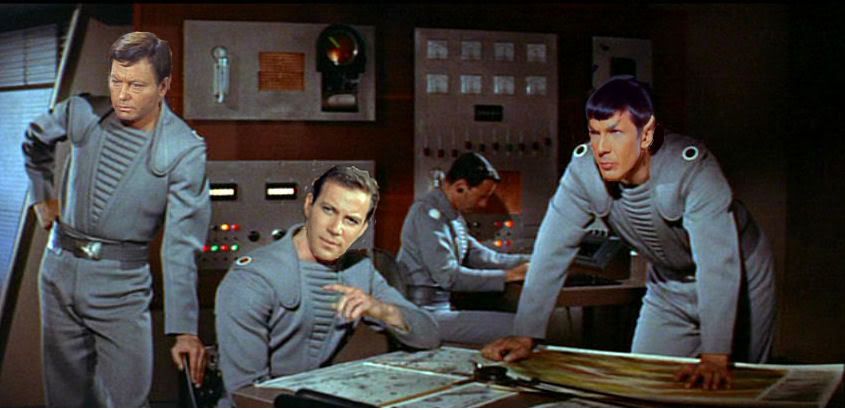I recently tracked down a copy of the November 20, 1964, script for The Cage and found something interesting.
In this script the sky of Talos IV is described as a "weird violet sky" with "twin suns." (Shades of Star Wars... in 1964!)
Also, the planet surface exhibits "multi-hued jagged rocks" and "here and there orangish vegetation not too dissimilar from Earth desert plants."
The idea of Talos as a binary star system goes back to the first-draft script of The Cage, and is noted in Harvey Lynn's scientific commentary on the first draft, as reprinted in The Making of Star Trek. Also included in The Making is Roddenberry's response to Lynn, which includes this paragraph:
"Reference the binary sun, am a little at a loss here on exactly what it should look like. Maybe when we get together next you can sketch out what it would look like from the planet surface. Of course, if it is too bizarre or confusing to the audience, we'll probably have to go back to a single sun."
As actually constructed, the Talos IV surface set indeed dropped the binary-sun idea, and used a painted green sky backdrop (which was infamously hard to light, inspiring the use of colored-gel-filter lighting on the series proper) instead of the violet sky color originally envisioned.
(Plus, the planet surface as built prominently featured blue plants, not orange ones...)
Of course, what famous science fiction movie has a green sky on an alien world? That's right, Forbidden Planet. The Altair IV sky in that film also has two moons prominently visible, a very otherworldly feature which resembles Roddenberry's twin-sun idea.
The Forbidden Planet sky was described in the shooting script as a "startling but beautiful chartreuse color" (that is, yellowish-green in hue), and is shown as such in concept art for the movie showcased in Cinefantastique. Curiously, though, the film's novelization calls the sky "turquoise" instead, i.e., blue-green.
(Just for the record, said novelization also describes, in addition to the two moons noted above, the planet's "red sand," "weird stalagmitic spears of blue-grey rock which thrust up through the sand in haphazard clusters" and "ranges of jagged green-grey mountains." I think we can safely say all this is not present in the final film.)
The storyboards for Forbidden Planet, however, took a very different approach, indicating a blue-black sky with lots of large planets and other celestial bodies visible. (And not just in that one drawing--additional storyboards show lots of planets in the Altair IV sky.)
In other words... Altair IV was supposed to have something like the infamously erroneous Vulcan sky in the theatrical cut of TMP?
If Roddenberry indeed changed the color of the alien Talos IV sky to match that of Altair IV (heck, even the planet's numeral is the same!), he wouldn't be alone in paying homage to a classic SF film. An early Star Wars script draft suggests that George Lucas considered making the sky of Tatooine, with its binary sun, green like that of Forbidden Planet.
In this script the sky of Talos IV is described as a "weird violet sky" with "twin suns." (Shades of Star Wars... in 1964!)
Also, the planet surface exhibits "multi-hued jagged rocks" and "here and there orangish vegetation not too dissimilar from Earth desert plants."
The idea of Talos as a binary star system goes back to the first-draft script of The Cage, and is noted in Harvey Lynn's scientific commentary on the first draft, as reprinted in The Making of Star Trek. Also included in The Making is Roddenberry's response to Lynn, which includes this paragraph:
"Reference the binary sun, am a little at a loss here on exactly what it should look like. Maybe when we get together next you can sketch out what it would look like from the planet surface. Of course, if it is too bizarre or confusing to the audience, we'll probably have to go back to a single sun."
As actually constructed, the Talos IV surface set indeed dropped the binary-sun idea, and used a painted green sky backdrop (which was infamously hard to light, inspiring the use of colored-gel-filter lighting on the series proper) instead of the violet sky color originally envisioned.
(Plus, the planet surface as built prominently featured blue plants, not orange ones...)
Of course, what famous science fiction movie has a green sky on an alien world? That's right, Forbidden Planet. The Altair IV sky in that film also has two moons prominently visible, a very otherworldly feature which resembles Roddenberry's twin-sun idea.
The Forbidden Planet sky was described in the shooting script as a "startling but beautiful chartreuse color" (that is, yellowish-green in hue), and is shown as such in concept art for the movie showcased in Cinefantastique. Curiously, though, the film's novelization calls the sky "turquoise" instead, i.e., blue-green.
(Just for the record, said novelization also describes, in addition to the two moons noted above, the planet's "red sand," "weird stalagmitic spears of blue-grey rock which thrust up through the sand in haphazard clusters" and "ranges of jagged green-grey mountains." I think we can safely say all this is not present in the final film.)
The storyboards for Forbidden Planet, however, took a very different approach, indicating a blue-black sky with lots of large planets and other celestial bodies visible. (And not just in that one drawing--additional storyboards show lots of planets in the Altair IV sky.)
In other words... Altair IV was supposed to have something like the infamously erroneous Vulcan sky in the theatrical cut of TMP?
If Roddenberry indeed changed the color of the alien Talos IV sky to match that of Altair IV (heck, even the planet's numeral is the same!), he wouldn't be alone in paying homage to a classic SF film. An early Star Wars script draft suggests that George Lucas considered making the sky of Tatooine, with its binary sun, green like that of Forbidden Planet.






